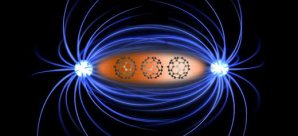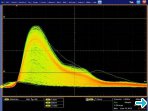Magnets made of non-magnetic metals
Muons were essential to show how non-magnetic metals become magnetic.
06/08/2015

Molecular interfaces make copper magnetic. Source: Uni. Leeds
For the first time scientists have shown how to make magnets out of inherently non-magnetic metals. The discovery could help develop new magnets for diverse applications as power generators or hard drives. The findings were published in the journal Nature.
The team, led by the University of Leeds, have applied a layer of carbon-60 molecules over thin copper and manganese films. The charge transfer at the interface between the two layers has changed the magnetic properties of the material so much that it became ferromagnetic and can thus be permanently magnetized.
The magnetic properties of such interface are not easy to investigate and the team had to use slow muons at the Paul Scherrer Institute (PSI) in Switzerland. Slow muons are ideal for this type of investigation because they can be placed very precisely in the vicinity of the interface area and are very sensitive to their magnetic environment. The experiments were supported through the NMI3 Access Programme .
The team were successful to show this basic principle. The next step will be to work on how to make the magnets stronger. These findings are important as magnets are used for a number of technical applications such as power generators, data storage on hard disks, or in devices for medical imaging.
Original Publication
F. A. Ma’Mari, T. Moorsom, G. Teobaldi, W. Deacon, T. Prokscha, H. Luetkens, S. Lee, G. E. Sterbinsky, D. A. Arena, D. A. MacLaren, M. Flokstra, M. Ali, M. Wheeler, G. Burnell, B. J. Hickey and O. Céspedes, Beating the stoner criterion using molecular interfaces, Nature (2015), Vol. 524, pp. 69–73 DOI: 10.1038/nature14621
Oscar Céspedes from the University of Leeds in the UK has received NMI3 support to conduct experiments at PSI in Switzerland.
Text based on materials from the PSI and University of Leeds. NMI3 thanks O. Céspedes for reviewing it.
Related news
Results from the NMI3 Muon JRA
Find out about the latest goals, achievements, and challenges of the NMI3 Muon Joint Research Activity.
Muons help understand mechanism behind hydrogen storage
Contrarily to what was previously thought, hydrogenation could be more effective at low temperatures. Read more.


